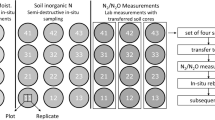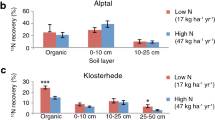Abstract
We analysed the stable isotope composition of emitted N2O in a one-year field experiment (June 1998 to April 1999) in unfertilized controls, and after adding nitrogen by applying slurry or mineral N (calcium ammonium nitrate). Emitted N2O was analysed every 2–4 weeks, with additional daily sampling for 10 days after each fertilizer application. In supplementary soil incubations, the isotopic composition of N2O was measured under defined conditions, favouring either denitrification or nitrification. Soil incubated for 48 h under conditions favouring nitrification emitted very little N2O (0.024 μmol gdw −1) and still produced N2O from denitrification. Under denitrifying incubation conditions, much more N2O was formed (0.91 μmol gdw −1 after 48 h). The isotope ratios of N2O emitted from denitrification stabilized at δ15N = −40.8 ± 5.7‰ and δ18O = 2.7 ± 6.3‰. In the field experiment, the N2O isotope data showed no clear seasonal trends or treatment effects. Annual means weighted by time and emission rate were δ15N = −8.6‰ and δ18O = 34.7‰ after slurry application, δ15N = −4.6‰ and δ18O = 24.0‰ after mineral fertilizer application and δ15N = −6.4‰ and δ18O = 35.6‰ in the control plots, respectively. So, in all treatments the emitted N2O was 15N-depleted compared to ambient air N2O (δ15N = 11.4 ± 11.6‰, δ18O = 36.9 ± 10.7‰). Isotope analyses of the emitted N2O under field conditions per se allowed no unequivocal identification of the main N2O producing process. However, additional data on soil conditions and from laboratory experiments point to denitrification as the predominant N2O source. We concluded (1) that the isotope ratios of N2O emitted from the field soil were not only influenced by the source processes, but also by microbial reduction of N2O to N2 and (2) that N2O emission rates had to exceed 3.4 μmol N2O m−2 h−1 to obtain reliable N2O isotope data.
Similar content being viewed by others
References
Arah J.R.M, Smith K.A., Crichton I.J. and Li H.S. 1991. Nitrous oxide production and denitrification in Scottish arable soils. J. Soil Sci. 42: 351–367.
Arah J.R.M., Crichton I.J. and Smith K.A. 1993. Denitrification measured directly using a single-inlet mass spectrometer and by acetylene inhibition. Soil Biol. Biochem. 25: 233–238.
Bauer G.A., Gebauer G., Harrison A.F., Högberg P., Högbom L., Schinkel H. et al. 2000. Biotic and abiotic controls over ecosystem cycling of stable natural nitrogen, carbon and sulphur isotopes. In: Schulze E.-D. (ed.), Carbon and Nitrogen Cycling in European Forest Ecosystems. Ecological Studies. Vol. 142. Springer-Verlag, Berlin-Heidelberg, Germany, pp. 189–214.
Blackmer A.M. and Bremner J.M. 1978. Inhibitory effect of nitrate on reduction of nitrous oxide to molecular nitrogen by soil microorganisms. Soil Biol. Biochem. 10: 187–191.
Brand W.A. 1995. PreCon: A fully automated interface for the pre-GC concentration of trace gases in air for isotopic analysis. Isotopes Environ. Health Stud. 31: 277–284.
Brenninkmeijer C.A.M. and Röckmann T. 1999. Mass spectrometry of the intra-molecular nitrogen isotope distribution of environmental nitrous oxide using fragment-ion analysis. Rapid Commun. Mass Spectrom. 13: 2028–2033.
Crutzen P.J. 1981. Atmospheric chemical processes of the oxides of nitrogen, including nitrous oxide. In: Delwiche C.C. (ed.), Denitrification, Nitrification and Atmospheric Nitrous Oxide. John Wiley and Sons, Chichester, UK, pp. 17–44.
Davidson E.A. 1991. Fluxes of nitrous oxide and nitric oxide from terrestrial ecosystems. In: Rogers J.E. and Whitman W.B. (eds), Microbial Production and Consumption of Greenhouse Gases: Methane, Nitrogen Oxides and Halomethanes. American Society for Microbiology, Washington, DC, USA, pp. 219–235.
Davidson E.A. 1992. Sources of nitric oxide and nitrous oxide following wetting of dry soil. Soil Sci. Soc. Am. J. 56: 95–102.
Durka W., Schulze E.D., Gebauer G. and Voerkelius S. 1994. Effects of forest decline on uptake and leaching of deposited nitrate determined from 15N and 18O measurements. Nature 372: 765–767.
Ehleringer J.R. and Rundel P.W. 1988. Stable isotopes: History, units and instrumentation. In: Rundel P.W., Ehleringer J.R. and Nagy K.A. (eds), Stable Isotopes in Ecological Research. Ecological Studies. Vol. 68. Springer-Verlag, Berlin-Heidelberg, Germany, pp. 1–19.
Firestone M.K. and Davidson E.A. 1989. Microbiological basis of NO and N2O production and consumption in soil. In: Andreae M.O. and Schimel D.S. (eds), Exchange of Trace Gases Between Terrestrial Ecosystems and the Atmosphere. John Wiley and Sons, Chichester, UK, pp. 7–21.
Goreau T.J., Kaplan W.A., Wofsy S.C., McElroy M.B., Valois F.W. and Watson S.W. 1980. Production of nitrite and nitrous oxide by nitrifying bacteria at reduced concentrations of oxygen. Appl. Environ. Microbiol. 40: 526–532.
Granli T. and Bøckman O.C. 1994. Nitrous oxide from agriculture. Norw. J. Agric. Sci. Suppl. No. 12.
Gross P.J. and Bremner J.M. 1992. Acetone problem in use of the acetylene blockage method for assessment of denitrifying activity in soil. Soil Biol. Biochem. 23: 299–302.
Högberg P. 1997. 15N natural abundance in soil-plant systems. Tansley Review No. 95. New Phytol. 137: 179–203.
Hynes R.K. and Knowles R. 1984. Production of nitrous oxide by Nitrosomonas europaea: effects of acetylene, pH, and oxygen. Can J. Microbiol. 30: 1397–1404.
IPCC - Intergovernmental Panel on Climate Change 1995. Climate change 1994 - radiative forcing of climate change and an evaluation of the IPCC IS92 emission scenarios. In: Houghton J.T., Meira Filho M.G., Bruce J., Hoesung Lee J., Callander B.A., Haites E. et al. (eds). Cambridge University Press, Cambridge, UK.
IPCC - Intergovernmental Panel on Climate Change 1996. Climate Change 1995 - The science of climate change. In: Houghton J.T., Meira Filho M.G., Callander B.A., Harris N., Kattenberg A. and Maskell K. (eds). Cambridge University Press, Cambridge, UK.
Khdyer I.I. and Cho C.M. 1983. Nitrification and denitrification of nitrogen fertilizers in a soil column. Soil Sci. Soc. Am. J. 47: 1134–1139.
Kim K.Y. and Craig H. 1990. Two-isotope characterization of N2O in the Pacific Ocean and constraints on its origin in deep water. Nature 347: 58–61.
Kim K.Y. and Craig H. 1993. Nitrogen-15 and oxygen-18 characteristics of nitrous oxide: A global perspective. Science 262: 1855–1857.
Klemedtsson L., Hansson G. and Mosier A. 1990. The use of acetylene for the quantification of N2 and N2O production from biological processes in soil. In: Revsbech N.P. and Sørensen J. (eds), Denitri-fication in Soil and Sediment. Plenum Press, New York, NY, USA, pp. 167–180.
Knowles R. 1982. Denitrification. Microb. Rev. 46: 43–70.
Knowles R. 1990. Acetylene inhibition technique: Development, advantages, and potential problems. In: Revsbech N.P. and Sørensen J. (eds), Denitrification in Soil and Sediment. Plenum Press, New York, NY, USA, pp. 151–166.
Malone J.P., Stevens R.J. and Laughlin R.J. 1997. Combining the 15N and acetylene inhibition techniques to examine the effect of acetylene on denitrification. Soil Biol. Biochem. 30: 31–37.
Mariotti A., Germon J.C. and Leclerc A. 1982. Nitrogen isotope fractionation associated with the NO -2 ? N2O step of denitrification in soils. Can. J. Soil Sci. 62: 227–241.
Mariotti A. 1983. Atmospheric nitrogen is a reliable standard for natural ?15N abundance measurements. Nature 303: 685–687.
Mosier A.R., Parton W.J. and Hutchinson G.L. 1983. Modelling nitrous oxide evolution from cropped and native soils. Environ. Biogeochem. Ecol. Bull. 35: 229–241.
Mosier A.R., Kroeze C., Nevison C., Oenema O., Seitzinger S. and van Cleemput O. 1998. Closing the global atmospheric N2O budget: nitrous oxide emissions through the agricultural nitrogen cycle. Nutr. Cyc. Agroecosys. 52: 225–248.
Parkin T.B. and Tiedje J.M. 1984. Application of a soil core method to investigate the effect of oxygen concentration on denitrification. Soil Biol. Biochem. 16: 331–334.
Payne W.J. 1981. The status of nitric oxide and nitrous oxide as intermediates in denitrification. In: Delwiche C.C. (ed.), Denitrification, Nitrification and Atmospheric Nitrous Oxide. John Wiley and Sons, Chichester, UK, pp. 85–103.
Poth M. and Focht D.D. 1985. 15N kinetic analysis of N2O production by Nitrosomonas europaea: an examination of nitrifier denitrification. Appl. Environ. Microbiol. 49: 1134–1141.
Ritchie G.A.F. and Nicholas D.J.D. 1972. Identification of nitrous oxide produced by oxidative and reductive processes in Nitrosomonas europaea. Biochem. J. 126: 1181–1191.
Robertson G.P. and Tiedje J.M. 1987. Nitrous oxide sources in aerobic soils: Nitrification, denitrification and other biological processes. Soil Biol. Biochem. 19: 187–193.
Schmidt H.-L. and Voerkelius S. 1989. Origin and isotope effects of oxygen in compounds of the nitrogen cycle. In: Isotopes in Nature, 5th Working Meeting, Proceedings. Leipzig, Germany.
Shearer G. and Kohl D.H. 1988. Nitrogen isotope fractionation and 18O-exchange in relation to the mechanism of denitrification of nitrite by Pseudomonas stutzeri. J. Biol. Chem. 263: 13231–13245.
Shearer G. and Kohl D.H. 1993. Natural abundance of 15N: fractional contribution of two sources to a common sink and use of isotopic discrimination. In: Knowles R. and Blackburn T.H. (eds), Nitrogen Isotope Techniques. Academic Press, New York, USA, pp. 89–125.
Tilsner J., Wrage N., Lauf J. and Gebauer G. 2002. Emission of gaseous nitrogen oxides from an extensively managed grassland ecosystem in NE Bavaria, Germany. I: Annual budgets of N2O and NOx emissions. Biogeochemistry (this issue).
Voerkelius S. 1990. Isotopendiskriminierungen bei der Nitrifikation und Denitrifikation; Grundlagen und Anwendungen der Herkunfts-Zuordnung von Nitrat und Distickstoffmonoxid. PhD Dissertation, Technical University of Munich, Germany.
Vogel J.C., Talma A.S. and Heaton T.H.E. 1981. Gaseous nitrogen as evidence for denitrification in groundwater. J. Hydrol. 50: 191–200.
Wahlen M. and Yoshinari T. 1985. Oxygen isotope ratios in N2O from different environments. Nature 313: 780–782.
Webster E.A. and Hopkins D.W. 1996. Nitrogen and oxygen isotope ratios of nitrous oxide emitted from soil and produced by nitrifying and denitrifying bacteria. Biol. Fertil. Soils 22: 326–330.
Weeg-Aerssens E., Tiedje J.M. and Averill B.A. 1987. The mechanism of microbial denitrification. J. Am. Chem. Soc. 109: 7214–7215.
Wrage N., Velthof G.L., van Beusichem M.L. and Oenema O. 2001. Role of nitrifier denitrification in the production of nitrous oxide. Soil Biol. Biochem. 33: 1723–1732.
Yoshida N. and Matsuo S. 1983. Nitrogen isotope ratio of atmospheric N2O as a key to the global cycle of N2O. Geochem. J. 17: 231–239.
Yoshida N. 1988. 15N-depleted N2O as a product of nitrification. Nature 335: 528–529.
Yoshinari T. 1990. Emissions of N2O from various environments. The use of stable isotope composition of N2O as tracer for the studies of N2O biogeochemical cycling. In: Revsbech N.P. and Sørensen J. (eds), Denitrification in Soil and Sediment. Plenum Press, New York, USA, pp. 129–150.
Zumft W.G. and Kroneck M.H. 1990. Metabolism of nitrous oxide. In: Revsbech N.P. and Sørensen J. (eds), Denitrification in Soil and Sediment. Plenum Press, New York, USA, pp. 37–55.
Rights and permissions
About this article
Cite this article
Tilsner, J., Wrage, N., Lauf, J. et al. Emission of gaseous nitrogen oxides from an extensively managed grassland in NE Bavaria, Germany. Biogeochemistry 63, 249–267 (2003). https://doi.org/10.1023/A:1023316315550
Issue Date:
DOI: https://doi.org/10.1023/A:1023316315550




